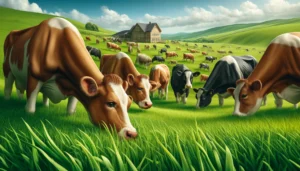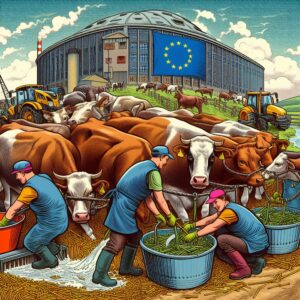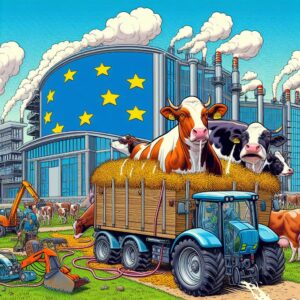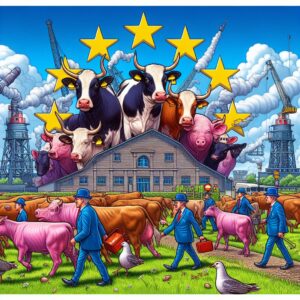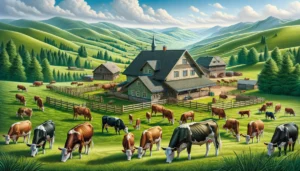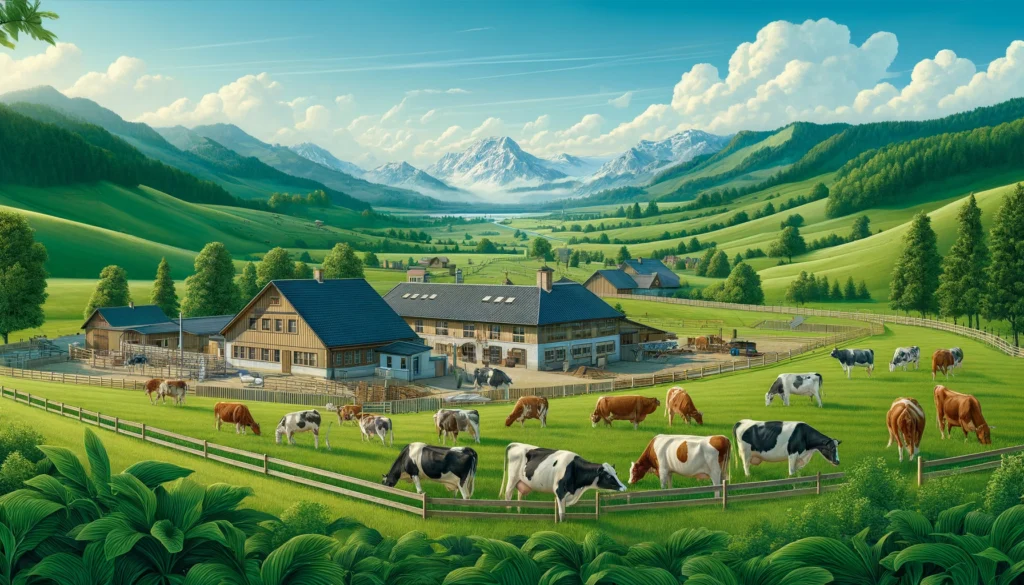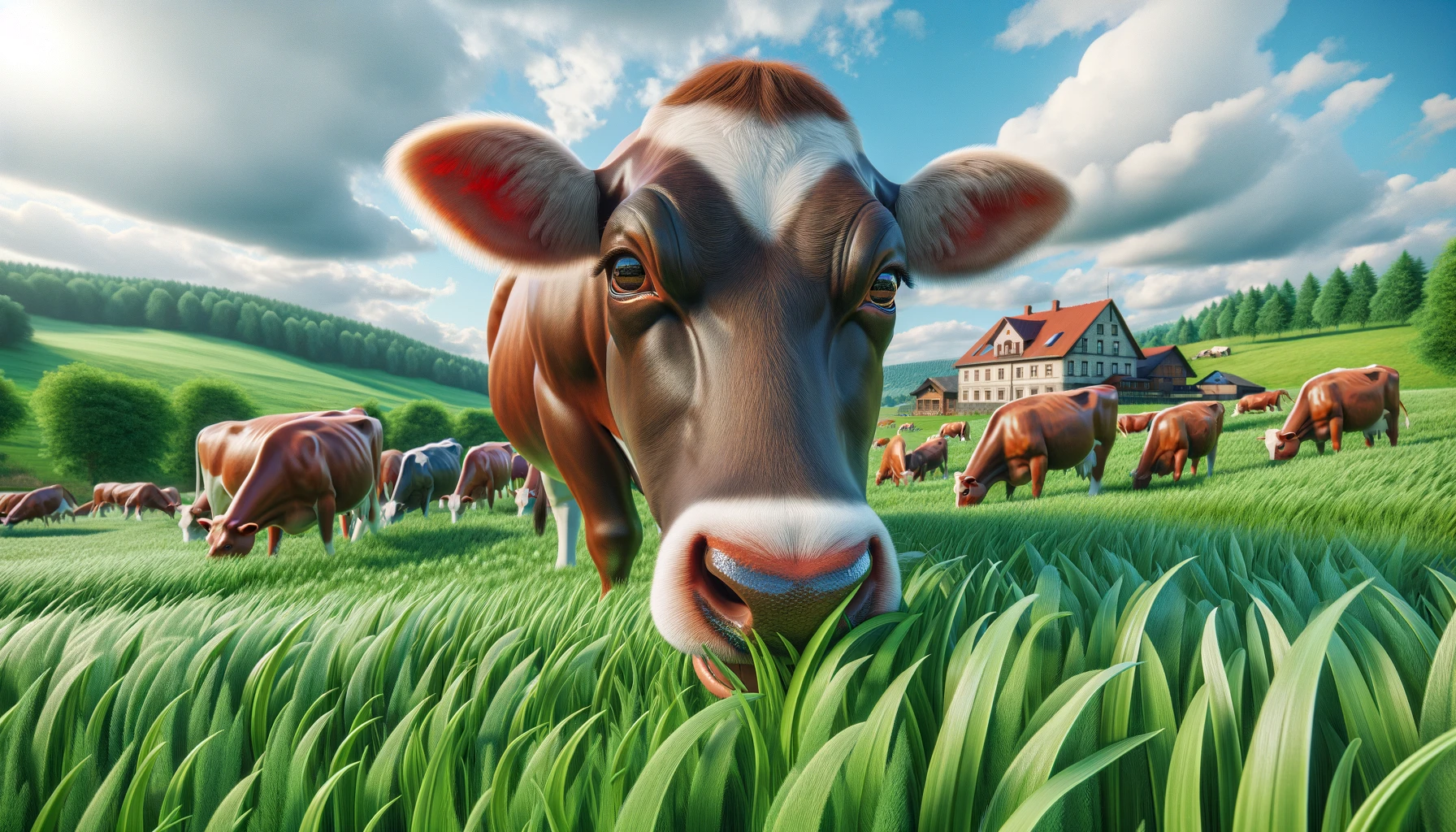Comprehensive Guide to Cattle Farming in Europe
Cattle farming is a significant agricultural activity in Europe, contributing to the region’s economy, food supply, and rural livelihoods. This comprehensive guide provides European cattle farmers with valuable insights, tips, and strategies for successful and sustainable cattle farming. We will cover various aspects, including breeding, nutrition, health management, housing, marketing, cost-effective solutions, and innovative practices.
Introduction to Cattle Farming in Europe
Importance of Cattle Farming
- Economic Contribution: Cattle farming plays a vital role in the European economy, providing income and employment to millions of people.
- Food Supply: Cattle farms produce essential food products, including beef and dairy, which are staples in the European diet.
- Rural Development: Cattle farming supports rural communities by sustaining agricultural activities and preserving cultural heritage.
Types of Cattle Farming
- Dairy Farming: Focuses on milk production for consumption and processing into dairy products like cheese, yogurt, and butter.
- Beef Farming: Involves raising cattle primarily for meat production, including various cuts of beef and processed meat products.
- Mixed Farming: Combines dairy and beef farming, allowing farmers to diversify their income streams and optimize resource use.
Breeding and Genetics
Selecting the Right Breeds
- Climate Adaptability: Choose breeds that are well-suited to the local climate and environmental conditions. Examples include Holstein for dairy and Angus for beef.
- Production Goals: Select breeds based on production goals, such as high milk yield, meat quality, disease resistance, and fertility.
- Crossbreeding: Consider crossbreeding to combine desirable traits from different breeds, enhancing productivity and resilience.
Breeding Management
- Artificial Insemination (AI): Use AI to access superior genetics and improve herd quality without the need for maintaining multiple bulls.
- Embryo Transfer (ET): Utilize ET to multiply valuable genetics quickly and efficiently.
- Selective Breeding: Practice selective breeding by choosing the best-performing animals for reproduction, focusing on traits like milk production, growth rate, and disease resistance.
Genetic Improvement Programs
- Performance Testing: Participate in performance testing programs to evaluate and compare the productivity of different animals.
- Genomic Selection: Use genomic selection techniques to identify and select animals with desirable genetic traits.
- Breed Societies: Engage with breed societies and associations that provide resources, support, and genetic improvement services.
Nutrition and Feeding
Nutritional Requirements
- Balanced Diet: Provide a balanced diet that meets the nutritional needs of cattle at different life stages, including energy, protein, vitamins, and minerals.
- Forage and Roughage: Ensure adequate forage and roughage, such as hay, silage, and pasture, to support digestion and overall health.
- Concentrates: Supplement with concentrates like grains and protein-rich feeds to meet the higher nutritional demands of lactating cows and growing calves.
Feeding Strategies
- Total Mixed Ration (TMR): Use TMR to provide a consistent and balanced diet, mixing forage, concentrates, and supplements.
- Grazing Management: Implement rotational grazing to optimize pasture utilization and maintain healthy forage.
- Seasonal Adjustments: Adjust feeding strategies based on seasonal variations in forage availability and nutritional needs.
Water Management
- Clean Water Supply: Ensure a continuous supply of clean, fresh water for drinking and feed mixing.
- Watering Systems: Use efficient watering systems, such as automatic waterers, to prevent wastage and contamination.
- Water Quality Monitoring: Regularly test water quality to detect contaminants and ensure it meets the health standards for cattle.
Health Management
Preventative Healthcare
- Vaccination Programs: Implement vaccination programs to protect cattle from common diseases and maintain herd health.
- Parasite Control: Regularly treat cattle for internal and external parasites, using appropriate medications and management practices.
- Biosecurity Measures: Establish biosecurity measures, such as quarantine protocols for new animals and disinfection of equipment, to prevent disease introduction and spread.
Disease Monitoring and Management
- Regular Health Checks: Conduct regular health checks and monitor cattle for signs of illness, injury, or stress.
- Early Detection: Train workers to recognize symptoms of common diseases and take prompt action when needed.
- Veterinary Support: Develop a strong relationship with a local veterinarian for routine health care and emergency support.
Stress Reduction
- Low-Stress Handling: Employ low-stress handling techniques to reduce anxiety and improve cattle welfare.
- Comfortable Housing: Provide comfortable, well-ventilated, and spacious housing to reduce stress and promote rest.
- Social Interaction: Allow cattle to interact and form social bonds, which can improve their overall well-being.
Housing and Facilities
Housing Types
- Freestall Barns: Provide individual stalls for each cow, allowing them to rest comfortably and reducing competition for space.
- Tie-Stall Barns: Secure cows in individual stalls with ties, commonly used in small-scale dairy farms.
- Open Housing: Use open housing systems, such as loose housing or pasture-based systems, to allow natural behaviors and movement.
Design Considerations
- Ventilation: Ensure proper ventilation to maintain air quality and prevent respiratory diseases.
- Bedding: Use appropriate bedding materials, such as straw, sand, or sawdust, to provide comfort and absorb moisture.
- Drainage: Design housing with adequate drainage to prevent water accumulation and reduce the risk of infections.
Feeding and Watering Facilities
- Feed Bunks: Install feed bunks or troughs that are easily accessible and minimize feed wastage.
- Water Troughs: Provide sufficient water troughs to ensure all cattle have access to clean water.
- Automatic Feeders: Consider using automatic feeders to ensure consistent and timely feeding.
Manure Management
- Manure Storage: Construct manure storage facilities that comply with environmental regulations and prevent runoff.
- Composting: Compost manure to produce nutrient-rich fertilizer for crops and reduce waste.
- Nutrient Management: Develop a nutrient management plan to utilize manure effectively and minimize environmental impact.
Marketing and Value Addition
Market Research
- Consumer Preferences: Understand consumer preferences and demand for beef and dairy products to tailor production accordingly.
- Market Trends: Stay informed about market trends, such as organic, grass-fed, or local products, to identify opportunities.
- Competitive Analysis: Analyze competitors to identify strengths, weaknesses, and potential market gaps.
Direct Marketing
- Farmers’ Markets: Sell directly to consumers at local farmers’ markets to build relationships and receive higher prices.
- CSA Programs: Offer Community Supported Agriculture (CSA) programs to provide consumers with regular deliveries of beef or dairy products.
- Online Sales: Utilize online platforms to reach a broader customer base and offer home delivery services.
Value-Added Products
- Processed Meat: Produce value-added meat products, such as sausages, jerky, and ready-to-cook meals, to increase revenue streams.
- Dairy Products: Process milk into cheese, yogurt, butter, and other dairy products to diversify income.
- Organic Certification: Obtain organic certification to access premium markets and attract health-conscious consumers.
Branding and Marketing
- Brand Identity: Develop a strong brand identity that reflects your farm’s values, quality, and unique selling points.
- Packaging: Use attractive and informative packaging to enhance product appeal and communicate key information.
- Promotion: Promote your products through social media, farm tours, and participation in local events to raise awareness and build a loyal customer base.
Cost-Effective Solutions and Money-Saving Hacks
Efficient Resource Management
- Bulk Purchasing: Buy inputs like feed, fertilizers, and equipment in bulk to take advantage of discounts and lower prices.
- Resource Sharing: Share machinery and equipment with neighboring farms to reduce capital expenditure and maintenance costs.
- DIY Repairs: Learn basic repair skills to fix machinery and equipment, saving money on professional services.
Low-Cost Technologies
- Homemade Feed: Make your own feed using locally available ingredients to reduce costs.
- Natural Pesticides: Use natural pesticides made from ingredients like neem oil, garlic, and soap to control pests without expensive chemicals.
- Solar Dryers: Build solar dryers to preserve fodder, adding value to your feed without high energy costs.
Energy Savings
- Energy-Efficient Equipment: Invest in energy-efficient machinery and appliances to reduce energy consumption and costs.
- Insulation: Insulate buildings and storage areas to maintain temperature and reduce heating and cooling expenses.
- LED Lighting: Replace traditional lighting with LED bulbs to save energy and reduce electricity bills.
Labor Optimization
- Seasonal Workers: Hire seasonal workers during peak periods like calving and harvesting to reduce labor costs.
- Training Programs: Invest in training programs for workers to improve efficiency and productivity.
- Mechanization: Use mechanized equipment for labor-intensive tasks to save time and reduce labor costs.
Budget-Friendly Options and Insider Secrets
DIY Solutions
- Homemade Fertilizers: Create your own organic fertilizers using compost, manure, and kitchen scraps.
- Simple Infrastructure: Build simple, cost-effective infrastructure like sheds, fences, and greenhouses using locally available materials.
- Natural Pest Control: Make natural pest control solutions using ingredients like garlic, chili peppers, and soap.
Collaborative Efforts
- Cooperatives: Join or form a farming cooperative to share resources, such as equipment and labor, and reduce individual costs.
- Knowledge Sharing: Network with other farmers to share tips, techniques, and solutions for common challenges.
Grants and Subsidies
- Government Programs: Apply for agricultural grants and subsidies offered by government agencies to support sustainable farming initiatives.
- Research Grants: Partner with universities or research institutions to access funding for innovative projects and trials.
Market Diversification
- Value-Added Products: Process your produce into value-added products like jams, juices, and dried fruits to increase revenue streams.
- Agri-Tourism: Offer farm tours, workshops, and farm stays to attract visitors and generate additional income.
Innovative Practices
- Precision Farming: Use precision farming technologies like GPS, drones, and sensors to optimize resource use and improve yields.
- Integrated Farming: Combine different farming activities, such as crop production and livestock rearing, to diversify income and improve sustainability.
Practical Tips for Successful Cattle Farming
Regular Monitoring
- Daily Inspections: Conduct daily inspections of cattle to identify issues early and take corrective action.
- Record Keeping: Maintain detailed records of farming activities, including breeding, feeding, and health treatments.
Balanced Nutrition
- Soil Testing: Regularly test soil to determine nutrient levels and adjust fertilization accordingly.
- Foliar Feeding: Apply foliar fertilizers during the growing season to address nutrient deficiencies quickly.
Water Management
- Efficient Irrigation: Use efficient irrigation systems like drip or micro-sprinklers to conserve water.
- Rainwater Harvesting: Collect and store rainwater for irrigation purposes to reduce dependence on external water sources.
Disease Prevention
- Sanitation: Practice good farm hygiene by regularly cleaning equipment, tools, and storage areas to prevent disease spread.
- Resistant Varieties: Plant disease-resistant crop varieties to minimize the need for chemical treatments.
Harvest Optimization
- Timely Harvesting: Harvest crops at the optimal stage of ripeness to ensure peak quality and yield.
- Proper Storage: Store harvested produce in appropriate conditions to extend shelf life and prevent spoilage.
Expert Advice for Farmers
Pest and Disease Management
- Integrated Pest Management (IPM): Use a combination of biological, cultural, and mechanical methods to manage pests and diseases.
- Biological Controls: Introduce beneficial insects and natural predators to control pest populations naturally.
Soil Health
- Organic Matter: Increase soil organic matter through cover cropping, composting, and reduced tillage practices.
- Soil Amendments: Use soil amendments like lime or gypsum to correct soil pH and improve structure.
Crop Selection
- Climate Suitability: Choose crops that are well-suited to your local climate and growing conditions.
- Market Demand: Select crops with high market demand to ensure profitability.
Sustainable Practices
- Water Conservation: Implement water-saving techniques like drip irrigation and mulching to conserve water.
- Renewable Energy: Use renewable energy sources like solar and wind to power farm operations.
Financial Management
- Budgeting: Create a detailed budget to track expenses and manage finances effectively.
- Cost-Benefit Analysis: Perform cost-benefit analyses for major investments to ensure they are financially viable.
Insider Secrets for Farmers
Enhancing Crop Quality
- Thinning: Thin excess plants to improve crop size, quality, and yield.
- Pruning: Regularly prune fruit trees and bushes to promote healthy growth and increase fruit production.
Extending Growing Season
- High Tunnels: Use high tunnels or hoop houses to extend the growing season and protect crops from adverse weather.
- Cold Frames: Build cold frames to start seedlings earlier and extend the harvest season.
Cost-Saving Measures
- Bulk Purchasing: Buy inputs like seeds, fertilizers, and pesticides in bulk to take advantage of discounts.
- Second-Hand Equipment: Purchase second-hand equipment to save money while maintaining functionality.
Labor Management
- Efficient Labor Use: Schedule labor-intensive tasks during cooler parts of the day to improve worker productivity and comfort.
- Seasonal Workers: Hire seasonal workers for peak periods to reduce labor costs and ensure timely completion of tasks.
Soil Health Practices
- Cover Cropping: Use cover crops to improve soil fertility, structure, and water retention.
- Composting: Incorporate compost into the soil to provide a slow-release source of nutrients and improve soil health.
Practical Examples and Case Studies
Case Study 1: Sustainable Cattle Farming
Location: Green Valley Farm, France
Practices:
- Soil Health: Green Valley Farm uses cover crops and compost to improve soil fertility and structure. Annual soil tests guide their fertilization program.
- Pest Management: The farm employs an integrated pest management (IPM) approach, using beneficial insects and natural predators to control pests. Regular scouting helps identify issues early.
- Water Conservation: Drip irrigation and rainwater harvesting reduce water use and costs. Mulching helps retain soil moisture and suppress weeds.
- Marketing: Green Valley Farm sells directly to consumers through a CSA program and farmers’ markets. They also produce value-added products like organic honey and herbal teas.
Outcomes: Green Valley Farm has achieved high crop quality, reduced input costs, and increased profitability through sustainable practices.
Case Study 2: Innovative Cattle Farming Practices
Location: Sunshine Farms, Spain
Practices:
- Water-Saving Techniques: Sunshine Farms implemented a precision drip irrigation system, reducing water use by 30%. Soil moisture sensors help optimize irrigation schedules.
- Rainwater Harvesting: The farm collects and stores rainwater for irrigation, reducing reliance on municipal water sources and lowering utility bills.
- Energy Efficiency: Solar panels power the irrigation system and cold storage units, reducing energy costs.
Outcomes: Sunshine Farms has significantly reduced water and energy costs while maintaining high crop quality and yield.
Case Study 3: Integrated Cattle Farming
Location: Eco-Farms, Germany
Practices:
- Organic Fertilizers: Eco-Farms uses compost, fish emulsion, and bone meal to provide nutrients. Soil tests guide their fertilization program.
- Natural Pest Control: The farm uses neem oil, insecticidal soap, and beneficial insects to manage pests. Crop rotation and cover crops reduce disease pressure.
- Sustainable Practices: Eco-Farms practices crop rotation, cover cropping, and mulching to improve soil health and reduce erosion.
Outcomes: Eco-Farms has achieved organic certification, reduced input costs, and increased market demand for their organic products.
Conclusion
Cattle farming in Europe requires careful planning, regular maintenance, and informed decision-making. By implementing the tips, expert advice, cost-effective solutions, money-saving hacks, budget-friendly options, and insider secrets outlined in this guide, European cattle farmers can optimize their operations, enhance productivity, and increase profitability. Remember to stay informed, adapt to changing conditions, and continuously seek innovative practices to ensure long-term success in your cattle farming endeavors.
Cattle Farm Image Gallery
